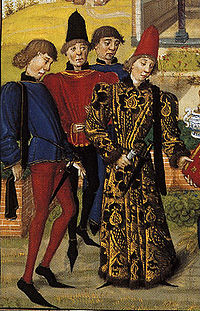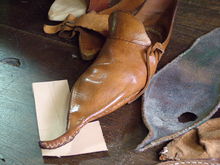- Crakow (shoe)
-
Crakows or crackowes were a style of shoes with extremely long toes very popular in the 15th century. They were so named because the style was thought to have originated in Kraków, then the capital of Poland. They began in the late 14th century and fell from fashion after about 1480–90. They were worn by men and women, but men's were the most extravagantly long.
Sometimes the point of the shoe (known as the "poulaine"[1] ) would need support from a whalebone or a string tied to the leg (just below the knee) to stop the point getting in the way when walking. (Examples from medieval London have the points stuffed with moss.[2]) Outdoors pattens or sandal-like clogs were usually worn underneath.
The Pope and the King Henry IV of England tried to stop this practice. The antiquarian John Stow wrote at the end of the 16th century that:
“ In Distar Lane, on the North side thereof, is the Cordwainer's (Shoemaker's) Hall, which company were made a brotherhood or fraternity in the 11th [year of reign] of Henry IV. Of these Cordwainers, I read, that since the 5th [year of reign] of Richard II (when he took to (married) wife Anne, daughter to Veselaus, King of Boheme), by her example the English people had used piked shoes, tied to their knees with silken laces, or chains of silver or gilt, wherefore in the fourth of Edward IV it was ordained and proclaimed, that beaks (the ends) of shoone (shoes) and boots, should not pass the length of two inches, upon pain of cursing by the clergy, and by Parliament to pay 20 shillings for every pair. And every cordwainer that sho[e]d any man or woman on the Sunday (day of rest), to pay 30 shillings.[3] ” — which matches the evidence of contemporary art well. Richard II married Anne of Bohemia in 1382, and "the fourth of Edward IV" is 1475, when the fashion was at its peak. The tying back to the leg is however rarely seen in the art of the period — it may have been something done when moving around, with the ties removed on arrival, or the prevalence of the habit may be exaggerated by censorious commentators.
Other sumptuary laws attempted to define by class how long shoes could be - the nobility were to be allowed two foot-lengths, merchants one, and peasants one half.[4] Like other attempts to control fashion by legislation, these seem to have failed.
At the Battle of Nicopolis in 1396, French Crusaders were forced to cut off the tips of their poulaines in order to be able to run away.[4]
Notes
- ^ The Encyclopaedia of the Renaissance. Market House Books. 1988. ISBN 0-7134-5967-0.
- ^ Grew, F. and de Neergaard, M. 1988. Shoes and Pattens. Medieval Finds from Excavations in London: 2. London: HMSO, pp. 88–9.
- ^ Stow's Survey of London, p. 351
- ^ a b Asimov, Isaac (1979). Isaac Asimov's Book of Facts. New York: Wings Books. pp. 113–114. ISBN 0-517-06503-7. "Named after its inventor, the poulaine was a shoe whose tip was a long as two feet for princes and noblemen, one foot for rich people of lower degree, and only half a foot for common people. Such shoes proved a hazard among the French Crusaders at the battle of Nicopolis (1396) when they had to cut off tips in order to be able to run away."
References
- Kohler, Carl: A History of Costume, Dover Publications reprint, 1963, ISBN 0-4862-1030-8
- Laver, James: The Concise History of Costume and Fashion, Abrams, 1979
- Payne, Blanche: History of Costume from the Ancient Egyptians to the Twentieth Century, Harper & Row, 1965. No ISBN for this edition; ASIN B0006BMNFS
See also
Footwear Men's dress shoes Brogues · Derbies · Loafers · Court shoes · Monks · Oxfords · Spectator shoes (Co-respondent shoes) · Venetian style shoes · Winklepickers · Brothel creepersWomen's dress shoes Ballet flats · Court shoes (Pumps) · Loafers · Slingbacks · Mules · Mary Janes · Mojari · Saddle shoes · Venetian style shoes · WinklepickersOther shoes Clog · Espadrilles · Flip-flops · Galoshes · Geta · Giveh · Moccasins · Platform shoes · Sandals · Slides · Slippers · VeldskoensMilitary footwear Ammunition boots · Cold weather boots · Combat boots · Jackboots · Jump boots · Jungle boots · Tactical boots · Tanker boots · Trench bootsSport-related footwear Fashion boots Work boots/shoes Australian work boots · Chukka boot · Cowboy boot · Hip boot · Rigger boot · Steel toe boots · Waders · Engineer bootsOther boots Historical Categories:- Shoes
- Polish clothing
- Medieval costume
Wikimedia Foundation. 2010.


